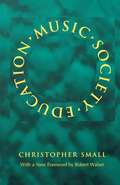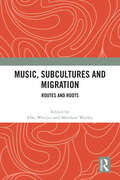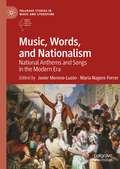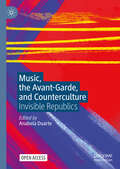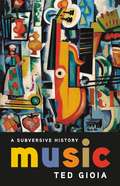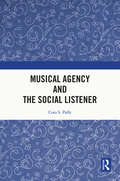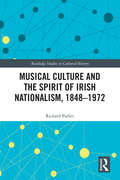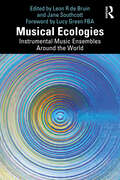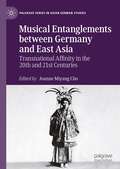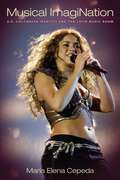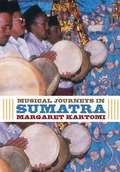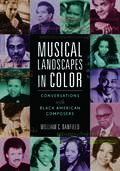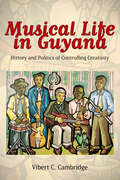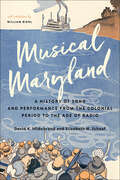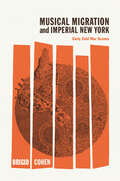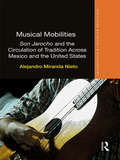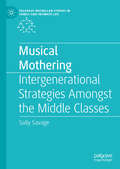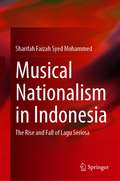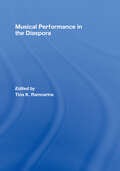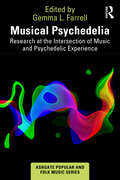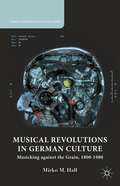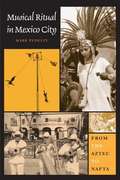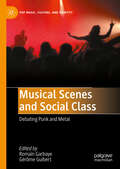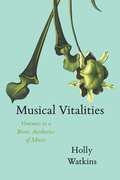- Table View
- List View
Music, Society, Education (Music Culture)
by Christopher Small Robert WalserCited by Soundpost as "remarkable and revolutionary" upon its publication in 1977, Music, Society, Education has become a classic in the study of music as a social force. Christopher Small sets out to examine the social implications of Western classical music, effects that until recently have been largely ignored or dismissed by most musicologists. He strives to view the Western musical tradition "through the mirror of these other musics [Balinese and African] as it were from the outside, and in so doing to learn something of the inner unspoken nature of Western culture as a whole."As series co-editor Robert Walser writes, "By pointing to the complicity of Western culture with Western imperialism, Small challenges us to create a future that is more humane than the past. And by writing a book that enables us to rethink so fundamentally our involvements with music, he teaches us how we might get there."
Music, Subcultures and Migration: Routes and Roots
by Matthew Worley Elke WeesjesThis edited volume concentrates on the period from the 1940s to the present, exploring how popular music forms such as blues, disco, reggae, hip hop, grime, metal and punk evolved and transformed as they traversed time and space. Within this framework, the collection traces how music and subcultures travel through, to and from democracies, autocracies and anocracies.The chosen approach is multidisciplinary and deliberately diverse. Using both archival sources and oral testimony from a wide variety of musicians, promoters, critics and members of the audience, contributors from a range of academic disciplines explore music and subcultural forms in countries across Asia, Europe, Oceania, North America and Africa. They investigate how far the meaning of music and associated subcultures change as they move from one context to another and consider whether they transcend or blur parameters of class, race, gender and sexuality.
Music, Words, and Nationalism: National Anthems and Songs in the Modern Era (Palgrave Studies in Music and Literature)
by Javier Moreno-Luzón María Nagore-FerrerMusic, Words and Nationalism: National Anthems and Songs in the Modern Era considers the concept of nationalism from 1780 to 2020 through anthems and national songs as symbolic and representative elements of the national identity of individuals, peoples, or collectivities. The volume shows that both the words and music of these works reveal a great deal about the defining features of a nation, its political and cultural history, and its self-perception. The book takes an interdisciplinary approach that provides a better understanding of the role of national anthems and songs in the expression of national identities and nationalistic goals. From this perspective, the relationship between hymns and political contexts, their own symbolic content (both literary and musical) and the role of specific hymns in the construction of national sentiments are surveyed.
Music, the Avant-Garde, and Counterculture: Invisible Republics
by Anabela DuarteThis book studies how the complex relationship between music, the avant-garde, and counterculture challenges all sorts of boundaries. By exploring the avant-garde as a thoughtful inquiry into experimentation, creativity, and originality, we bring to the fore the "invisible republics" of culture, the ephemeral, the suppressed, and the unconformity of artistic and political undercurrents. Avant-garde and experimental art are international in scope, and their trajectory, as we see it, has been to expand themselves towards a new enlightenment, a critical project, and a rhizomatic entity, albeit with tacit harmony and cohesion. From Bucharest to Paris, London to New York, Paris to Brazil, Cuba, or Chile, to name a few, the same urge for the unknown and anti-art poetics emerged almost simultaneously in every field. We ask how these separate geographical territories (and practices) speak to each other and how this might reshape scholars' historical understanding of European and American modernity. This is an open access book.
Music: A Subversive History
by Ted GioiaA preeminent music historian and critic presents a global history of music from the bottom upHistories of music overwhelmingly suppress stories of the outsiders and rebels who created musical revolutions and instead celebrate the mainstream assimilators who borrowed innovations, diluted their impact, and disguised their sources. In Music: A Subversive History, historian Ted Gioia reclaims the story of music for the riffraff, insurgents, and provocateurs.Gioia tells a four-thousand-year history of music as a global source of power, change, and upheaval. He shows how social outcasts have repeatedly become trailblazers of musical expression: slaves and their descendants, for instance, have repeatedly reinvented music, from ancient times all the way to the jazz, reggae, and hip-hop sounds of the current day. Music: A Subversive History is essential reading for anyone interested in the meaning of music, from Sappho to the Sex Pistols to Spotify.
Musical Agency and the Social Listener
by Cora S. PalfyMusic as a narrative drama is an intriguing idea, which has captured explicit music theoretical attention since the nineteenth century. Investigations into narrative characters or personae has evolved into a sub-field—musical agency. In this book, Palfy contends that music has the potential to engage us in social processes and that those processes can be experienced as a social interaction with a musical agent. She explores the overlap between the psychological processes in which we participate in order to understand and engage with people, and those we engage in when we listen to music. Thinking of musical agency as a form of social process is quite different from existing theoretical frameworks for agency. It implies that we come to musical analysis by way of intuition—that our ideas are already partially formed based on our experience of the piece (and what it makes us feel or how it makes us sense it as any other) when we choose to analyze and interpret it. Palfy’s focus on social processes is a very effective way to pinpoint when and why it is that our attention is captured and engaged by musical agents.
Musical Culture and the Spirit of Irish Nationalism, 1848–1972 (Routledge Studies in Cultural History #77)
by Richard ParfittMusical Culture and the Spirit of Irish Nationalism is the first comprehensive history of music’s relationship with Irish nationalist politics. Addressing rebel songs, traditional music and dance, national anthems and protest song, the book draws upon an unprecedented volume of material to explore music’s role in cultural and political nationalism in modern Ireland. From the nineteenth-century Young Irelanders, the Fenians, the Home Rule movement, Sinn Féin and the Anglo-Irish War to establishment politics in independent Ireland and civil rights protests in Northern Ireland, this wide-ranging survey considers music’s importance and its limitations across a variety of political movements.
Musical Ecologies: Instrumental Music Ensembles Around the World
by Jane Southcott de Bruin, Leon RCommunity music around the world reflects the growing and diverse ways humans collectivise and express themselves in ways that articulate our cultural, social, and environmental complexity. Revisiting, redevising, and reimagining some of the field’s approaches, ideologies, and contexts, this co-edited volume investigates beyond generalist intercultural and internationalist concepts to reveal the complexity of social ways people come together to make music and to making music be central to this sociality.The authors explore the role community music plays out around the world and how various instrumentally based music-making communities operate as ecologies that allow notions of social, political, and cultural agency and identity/ies. Chapters cover various instrumental community music ensembles, observing how they, as social microcosms of change and stasis, provide working methods new and old, extol values, and model ethical behaviours that are fluid and dynamic, steadfast and unyielding, and that contribute to the ebb and flow of people and their agency that remains under-researched. Insights are provided on variously functioning ensembles throughout the world, showing how myriad instrumental music communities act as drivers, complex environments, and apparati for musical and social expression that accommodates the musical aspirations of their members.Taken as a whole, this book explores community music as local, glocal, global phenomena, critically discussing the redefinition of community music and what music-making means to people in the twenty-first century.
Musical Entanglements between Germany and East Asia: Transnational Affinity in the 20th and 21st Centuries (Palgrave Series in Asian German Studies)
by Joanne Miyang ChoThis edited volume explores musical encounters and entanglements between Germany and East Asian nations from 1900 to the present. In so doing, it speaks to their dynamic and multi-faceted musical relations in multiple ways. Despite East Asia and Germany being located at opposite ends of the globe, German music has found remarkably fertile soil in East Asia. East Asians have enthusiastically adopted it, while at the same time adding their own musical interpretations. These musical encounters have produced compositions that reflect this mutual influence, stimulating and enriching each other through their entanglement. After more than a century of entanglement, Germany and East Asia have become kindred musical spirits.
Musical ImagiNation: U.S-Colombian Identity and the Latin Music Boom
by Maria Elena CepedaLong associated with the pejorative clichés of the drug-trafficking trade and political violence, contemporary Colombia has been unfairly stigmatized. In this pioneering study of the Miami music industry and Miami’s growing Colombian community, María Elena Cepeda boldly asserts that popular music provides an alternative common space for imagining and enacting Colombian identity. Using an interdisciplinary analysis of popular media, music, and music video, Cepeda teases out issues of gender, sexuality, race, ethnicity, and transnational identity in the Latino/a music industry and among its most renowned rock en español, pop, and vallenato stars.Musical ImagiNation provides an overview of the ongoing Colombian political and economic crisis and the dynamics of Colombian immigration to metropolitan Miami. More notably, placed in this context, the book discusses the creative work and media personas of talented Colombian artists Shakira, Andrea Echeverri of Aterciopelados, and Carlos Vives. In her examination of the transnational figures and music that illuminate the recent shifts in the meanings attached to Colombian identity both in the United States and Latin America, Cepeda argues that music is a powerful arbitrator of memory and transnational identity.
Musical Journeys in Sumatra
by Margaret KartomiDespite being the sixth largest island in the world and home to an estimated 44 million Indonesians, Sumatra's musical arts and cultures have not been the subject of a book-length study until now. Documenting and explaining the ethnographic, cultural, and historical contexts of Sumatra's performing arts, Musical Journeys in Sumatra also traces the changes in their style, content, and reception from the early 1970s onward. Having dedicated thirty years of scholarship to exploring the rich and varied music of Sumatran provinces, Margaret Kartomi provides a fascinating ethnographic record of vanishing musical genres, traditions, and practices that have become deeply compromised by the pressures of urbanization, rural poverty, and government policy in. This unique collection showcases the complex diversity of Indonesian music and includes field observations from five different provinces: Aceh, North Sumatra, Riau, West Sumatra, and South Sumatra. Featuring unique photographs and original drawings from Kartomi's field observations of instruments and performances, Musical Journeys in Sumatra provides a comprehensive musical introduction to this neglected, very large island, with its hundreds of ethno-linguistic-musical groups.
Musical Landscapes in Color: Conversations with Black American Composers (Music in American Life)
by William C. BanfieldNow available in paperback, William C. Banfield’s acclaimed collection of interviews delves into the lives and work of forty-one Black composers. Each of the profiled artists offers a candid self-portrait that explores areas from training and compositional techniques to working in a exclusive canon that has existed for a very long time. At the same time, Banfield draws on sociology, Western concepts of art and taste, and vernacular musical forms like blues and jazz to provide a frame for the artists’ achievements and help to illuminate the ongoing progress and struggles against industry barriers. Expanded illustrations and a new preface by the author provide invaluable added context, making this new edition an essential companion for anyone interested in Black composers or contemporary classical music. Composers featured: Michael Abels, H. Leslie Adams, Lettie Beckon Alston, Thomas J. Anderson, Dwight Andrews, Regina Harris Baiocchi, David Baker, William C. Banfield, Ysaye Maria Barnwell, Billy Childs, Noel DaCosta, Anthony Davis, George Duke, Leslie Dunner, Donal Fox, Adolphus Hailstork, Jester Hairston, Herbie Hancock, Jonathan Holland, Anthony Kelley, Wendell Logan, Bobby McFerrin, Dorothy Rudd Moore, Jeffrey Mumford, Gary Powell Nash, Stephen Newby, Coleridge-Taylor Perkinson, Michael Powell, Patrice Rushen, George Russell, Kevin Scott, Evelyn Simpson-Curenton, Hale Smith, Billy Taylor, Frederick C. Tillis, George Walker, James Kimo Williams, Julius Williams, Tony Williams, Olly Wilson, and Michael Woods
Musical Life in Guyana: History and Politics of Controlling Creativity (Caribbean Studies Series)
by Vibert C. CambridgeMusical Life in Guyana is the first in-depth study of Guyanese musical life. It is also a richly detailed description of the social, economic, and political conditions that have encouraged and sometimes discouraged musical and cultural creativity in Guyana. The book contributes to the study of the interactions between the policies and practices by national governments and musical communities in the Caribbean. Vibert C. Cambridge explores these interactions in Guyana during the three political eras that the society experienced as it moved from being a British colony to an independent nation. The first era to be considered is the period of mature colonial governance, guided by the dictates of “new imperialism,” which extended from 1900 to 1953. The second era, the period of internal self-government and the preparation for independence, extends from 1953, the year of the first general elections under universal adult suffrage, to 1966, the year when the colony gained its political independence. The third phase, 1966 to 2000, describes the early postcolonial era. Cambridge reveals how the issues of race, class, gender, and ideology deeply influenced who in Guyanese multicultural society obtained access to musical instruction and media outlets and thus who received recognition. He also describes the close connections between Guyanese musicians and Caribbean artists from throughout the region and traces the exodus of Guyanese musicians to the great cities of the world, a theme often neglected in Caribbean studies. The book concludes that the practices of governance across the twentieth century exerted disproportionate influence in the creation, production, distribution, and consumption of music.
Musical Maryland: A History of Song and Performance from the Colonial Period to the Age of Radio
by David K. Hildebrand Elizabeth M. SchaafThe only book to delve deeply into Maryland’s rich musical performance history and the people who created it.In Musical Maryland, the first comprehensive survey of the music emanating from the Old Line State, David K. Hildebrand and Elizabeth M. Schaaf explore the myriad ways in which music has enriched the lives of Marylanders. From the drinking songs of colonial Annapolis, the liturgical music of the Zion Lutheran Church, and the work songs of the tobacco fields to the exuberant marches of late nineteenth-century Baltimore Orioles festivals, Chick Webb’s mastery on drums, and the triumphs of the Baltimore Opera Society, this richly illustrated volume explores more than 300 years of Maryland’s music history.Beginning with early compositions performed in private settings and in public concerts, this book touches on the development of music clubs like the Tuesday Club, the Florestan Society, and H. L. Mencken’s Saturday Night Club, as well as lasting institutions such as the Peabody Institute and the Baltimore Symphony Orchestra (BSO). Yet the soundscape also includes militia quicksteps, sea chanteys, and other work songs. The book describes the writing of "The Star-Spangled Banner"—perhaps Maryland's single greatest contribution to the nation's musical history. It chronicles the wide range of music created and performed by Maryland’s African American musicians along Pennsylvania Avenue in racially segregated Baltimore, from jazz to symphonic works. It also tells the true story of a deliberately integrated concert that the BSO staged at the end of World War II. The book is full of musical examples, engravings, paintings, drawings, and historic photographs that not only portray the composers and performers but also the places around the state in which music flourished. Illuminating sidebars by William Biehl focus on late nineteenth- and early twentieth-century song of the kind evoked by the USS Baltimore or inspired by the state's history, natural beauty, and romantic steamboats. The book also offers a sampling of the tunes that Maryland’s more remarkable composers and performers, including Billie Holiday, Eubie Blake, and Cab Calloway, contributed to American music before the homogenization that arrived in earnest after World War II.Bringing to life not only portraits of musicians, composers, and conductors whose stories and recollections are woven into the fabric of this book, but also musical scores and concert halls, Musical Maryland is an engaging, authoritative, and bold look at an endlessly compelling subject.
Musical Migration and Imperial New York: Early Cold War Scenes (New Material Histories of Music)
by Brigid CohenThrough archival work and storytelling, Musical Migration and Imperial New York revises many inherited narratives about experimental music and art in postwar New York. From the urban street level of music clubs and arts institutions to the world-making routes of global migration and exchange, this book redraws the map of experimental art to reveal the imperial dynamics and citizenship struggles that continue to shape music in the United States. Beginning with the material conditions of power that structured the cityscape of New York in the early Cold War years, Brigid Cohen looks at a wide range of artistic practices (concert music, electronic music, jazz, performance art) and actors (Edgard Varèse, Charles Mingus, Yoko Ono, and Fluxus founder George Maciunas) as they experimented with new modes of creativity. Cohen links them with other migrant creators vital to the city’s postwar culture boom, creators whose stories have seldom been told (Halim El-Dabh, Michiko Toyama, Vladimir Ussachevsky). She also gives sustained and serious treatment to the work of Yoko Ono, something long overdue in music scholarship. Musical Migration and Imperial New York is indispensable reading, offering a new understanding of global avant-gardes and American experimental music as well as the contrasting feelings of belonging and exclusion on which they were built.
Musical Migration and Imperial New York: Early Cold War Scenes (New Material Histories of Music)
by Brigid CohenThrough archival work and storytelling, Musical Migration and Imperial New York revises many inherited narratives about experimental music and art in postwar New York. From the urban street level of music clubs and arts institutions to the world-making routes of global migration and exchange, this book redraws the map of experimental art to reveal the imperial dynamics and citizenship struggles that continue to shape music in the United States. Beginning with the material conditions of power that structured the cityscape of New York in the early Cold War years, Brigid Cohen looks at a wide range of artistic practices (concert music, electronic music, jazz, performance art) and actors (Edgard Varèse, Charles Mingus, Yoko Ono, and Fluxus founder George Maciunas) as they experimented with new modes of creativity. Cohen links them with other migrant creators vital to the city’s postwar culture boom, creators whose stories have seldom been told (Halim El-Dabh, Michiko Toyama, Vladimir Ussachevsky). She also gives sustained and serious treatment to the work of Yoko Ono, something long overdue in music scholarship. Musical Migration and Imperial New York is indispensable reading, offering a new understanding of global avant-gardes and American experimental music as well as the contrasting feelings of belonging and exclusion on which they were built.
Musical Mobilities: Son Jarocho and the Circulation of Tradition Across Mexico and the United States (Routledge Advances in Ethnography)
by Alejandro Miranda NietoHow do musical practices move? Though technology increasingly plays a great part in establishing different degrees of spatial proximity, music making still seems to be tied to specific geographical locations, cultures or communities. The identity of musical traditions, in particular, is often demarcated by a presumed degree of uniformity amongst its practitioners. Musical Mobilities analyses how a musical tradition moves literally and metaphorically: the ways in which people, objects and information travel across geographical locations, just as practices as recognisable entities circulate along with meanings, competencies and embodied dispositions. This unique ethnography focuses on son jarocho, a musical practice originating in southeast Mexico that is currently reproduced through transnational connections, particularly in the United States. Paradoxically, the transformation of son jarocho has been a noticeable outcome of its recuperation and preservation. Thus, in describing the moves of this musical tradition, this book provides a theoretical and empirical perspective on the dissonances between cultural continuity and change. The first ethnographic work to explicitly address the continuity and transformation of a musical practice through the analysis of multiple forms of mobility and fixity, Musical Mobilities will appeal to undergraduate and postgraduate students and postdoctoral researchers interested in fields such as Latin American & Hispanic Studies, South American Music, Ethnomusicology, Cultural Studies and Sociology of Culture.
Musical Mothering: Intergenerational Strategies Amongst the Middle Classes (Palgrave Macmillan Studies in Family and Intimate Life)
by Sally SavageThis book examines how gender and class discourses shape 'musical mothering' by incorporating knowledges from sociology, psychology, cultural studies, and education. Chapters detail the fundamental and functional role that mothers play in children's musical development alongside children's agency in influencing familial experiences. Music plays an essential role in the lives of mothers for themselves. Through interviews with mothers and grandmothers, as well as the author's own autobiographical reflections, the author offers a unique interdisciplinary approach to motherhood and music within Australian culture.
Musical Nationalism in Indonesia: The Rise and Fall of Lagu Seriosa
by Sharifah Faizah MohammedThis book charts the growth of the Indonesian nationalistic musical genre of lagu seriosa in relation to the archipelago's history in the 1950s and 1960s, examining how folk songs were implemented as a valuable tool for promoting government propaganda. The author reveals how the genre was shaped to fit state ideologies and agendas in the Sukarno and Soeharto eras. It also reveals the very significant role played by Radio Republik Indonesia in the genre’s development and dissemination. Little research has been done to investigate how Indonesian music contributed to nation-building during Indonesia’s immediate post-colonial period. Emulating the European art song, the genre was adapted to compose songs with the purpose of promoting a strengthened collective Indonesian identity, fostered by a group of musicians who functioned as gatekeepers, monitoring and devising various mechanisms for songs to conform to the propagandistic needs of the Indonesian government at the time. The result was the development of classical style of singing and the cultivation of a patriotic collection of music during the Guided Democracy period (1959–1965), which peaked at the height of the Konfrontasi (1963–1966). Lagu seriosa lost popularity as popular music infiltrated Indonesia in the 1970s, but it remains an iconic yet understudied aspect of the nationalistic agenda in Indonesia. The case studies of selected songs reflected continuity and change in musical style and over time. This book is of interest to scholars studying the intersection between history, politics, identity, arts and cultural studies in Indonesia. It is also of interest to researchers investigating the role of music in identity formation and nation-building more widely.
Musical Performance in the Diaspora
by Tina K. RamnarineThis book illustrates how ethnographic investigation of musical performances might contribute to the analysis of diaspora. It embraces diverse examples such as 'mourning and cultures of survival' amongst Aboriginal and Jewish communities in Australia, remembering a Kazakh 'homeland' in Western Mongolia, celebrating Diwali in New Zealand and the circulation of musical performances in Mozambique, Portugal and the UK. Some of the topics discussed in Musical Performance in the Diaspora include: the expression and shaping of diasporic and postcolonial identities through performance musical memory in diasporic contexts the geographies of performance the politics of 'new' forms of diasporic music-making. This book presents a rich array of theoretical approaches and wide ranging ethnographic case studies to reconsider and challenge discourses that have favoured uncritical notions of diasporic 'hybridity' and to broaden current analyses of performance in the diaspora.
Musical Psychedelia: Research at the Intersection of Music and Psychedelic Experience (Ashgate Popular and Folk Music Series)
by Gemma L. FarrellPsychedelic music is a fascinating yet under-researched field of study. This thought-provoking collection offers a broad introduction to the fi eld of psychedelic music studies, bringing together scholarly work on psychedelic music in genres like rock, folk, electronic dance music and pop. Through an expanded purview on psychedelic music, an emerging trend in research, the collection affords students and academics alike an introduction to a rich, multi-faceted field. The contributing authors explore a range of different facets of musical psychedelia: its transgressive and transcendent aspects, its foregrounding of timbre and texture, the way it changes our perception of time, its influence on “non-psychedelic” music, key composition and production techniques that composers and musicians use in its creation, how it is mediated by different places and spaces, and the interplay between psychedelic visual and sonic aesthetics. This interdisciplinary work reveals both commonalities in musical psychedelic experiences and the contestation inherent in a fi eld of study that juxtaposes music of different genres and eras with a variety of theoretical approaches and methodologies. In broadening the scope of psychedelic music research, the collection not only makes for varied and absorbing reading on the subject level but also stimulates reflexive thought about interdisciplinary research.
Musical Revolutions in German Culture
by Mirko M. HallMusical Revolutions in German Culture explores the persistence of a critical-deconstructive philosophy toward musical production, consumption, and reception in Germany over the past two centuries. Drawing upon the cultural-revolutionary insights of Friedrich Schlegel, Walter Benjamin, Theodor W. Adorno, and Blixa Bargeld, this book investigates how radical musical discourses and practices engage sound as a powerful site of cultural creativity, critique, and resistance. Intellectual historian Mirko M. Hall shows how music, when intentionally situated within certain counterhegemonic aesthetic practices, can decisively transform everyday consciousness in the service of human freedom.
Musical Ritual in Mexico City: From the Aztec to NAFTA
by Mark PedeltyOn the Zócalo, the main square of Mexico City, Mexico's entire musical history is performed every day. "Mexica" percussionists drum and dance to the music of Aztec rituals on the open plaza. Inside the Metropolitan Cathedral, choristers sing colonial villancicos. Outside the National Palace, the Mexican army marching band plays the "Himno Nacional," a vestige of the nineteenth century. And all around the square, people listen to the contemporary sounds of pop, rock, and música grupera. In all, some seven centuries of music maintain a living presence in the modern city. This book offers an up-to-date, comprehensive history and ethnography of musical rituals in the world's largest city. Mark Pedelty details the dominant musical rites of the Aztec, colonial, national, revolutionary, modern, and contemporary eras, analyzing the role that musical ritual played in governance, resistance, and social change. His approach is twofold. Historical chapters describe the rituals and their functions, while ethnographic chapters explore how these musical forms continue to resonate in contemporary Mexican society. As a whole, the book provides a living record of cultural continuity, change, and vitality.
Musical Scenes and Social Class: Debating Punk and Metal (Pop Music, Culture and Identity)
by Romain Garbaye Gérôme Guibert“In a fragmentation and large-scale social crisis context, this volume takes up the debate between punk and metal and class belonging, showing us the interrelations between practices and their determination by social belongings. A vital feature of the book is the demonstration of the self-renewal of punk and metal. The irreverence, resistance, and personification of subaltern and paradoxical identities portrayed here represent a step forward “ —Paula Guerra, KISMIF Co-Convenor, University of Porto, Portugal Early analysts of both punk and metal have shown their continuing popularity for segments of the public who were often considered in the 1970s and 1980s as “losers of globalization” despite the level of fragmentation of these scenes, the diversity of their audiences’ backgrounds, and their constant evolution and re-invention. This volume aims to stimulate and contribute to debates on social class and economic and cultural change, on one side, and punk and metal, on the other, through international, contemporary and historical approaches, mainly focused on Britain and France.
Musical Vitalities: Ventures in a Biotic Aesthetics of Music (New Material Histories of Music)
by Holly WatkinsDoes it make sense to refer to bird song—a complex vocalization, full of repetitive and transformative patterns that are carefully calculated to woo a mate—as art? What about a pack of wolves howling in unison or the cacophony made by an entire rain forest? Redefining music as “the art of possibly animate things,” Musical Vitalities charts a new path for music studies that blends musicological methods with perspectives drawn from the life sciences. In opposition to humanist approaches that insist on a separation between culture and nature—approaches that appear increasingly untenable in an era defined by human-generated climate change—Musical Vitalities treats music as one example of the cultural practices and biotic arts of the animal kingdom rather than as a phenomenon categorically distinct from nonhuman forms of sonic expression. The book challenges the human exceptionalism that has allowed musicologists to overlook music’s structural resemblances to the songs of nonhuman species, the intricacies of music’s physiological impact on listeners, and the many analogues between music’s formal processes and those of the dynamic natural world. Through close readings of Austro-German music and aesthetic writings that suggest wide-ranging analogies between music and nature, Musical Vitalities seeks to both rekindle the critical potential of nineteenth-century music and rejoin the humans at the center of the humanities with the nonhumans whose evolutionary endowments and planetary fates they share.
